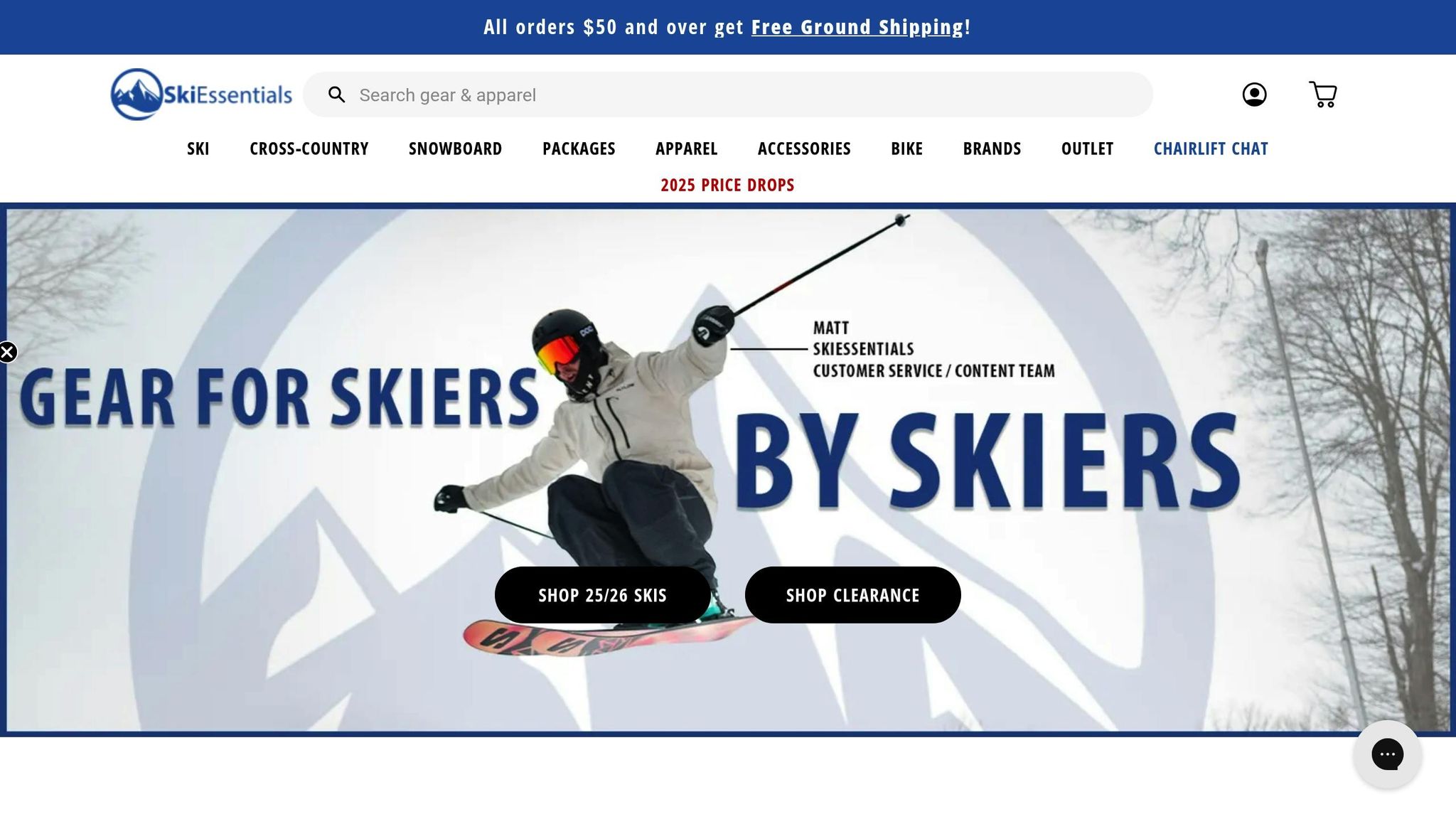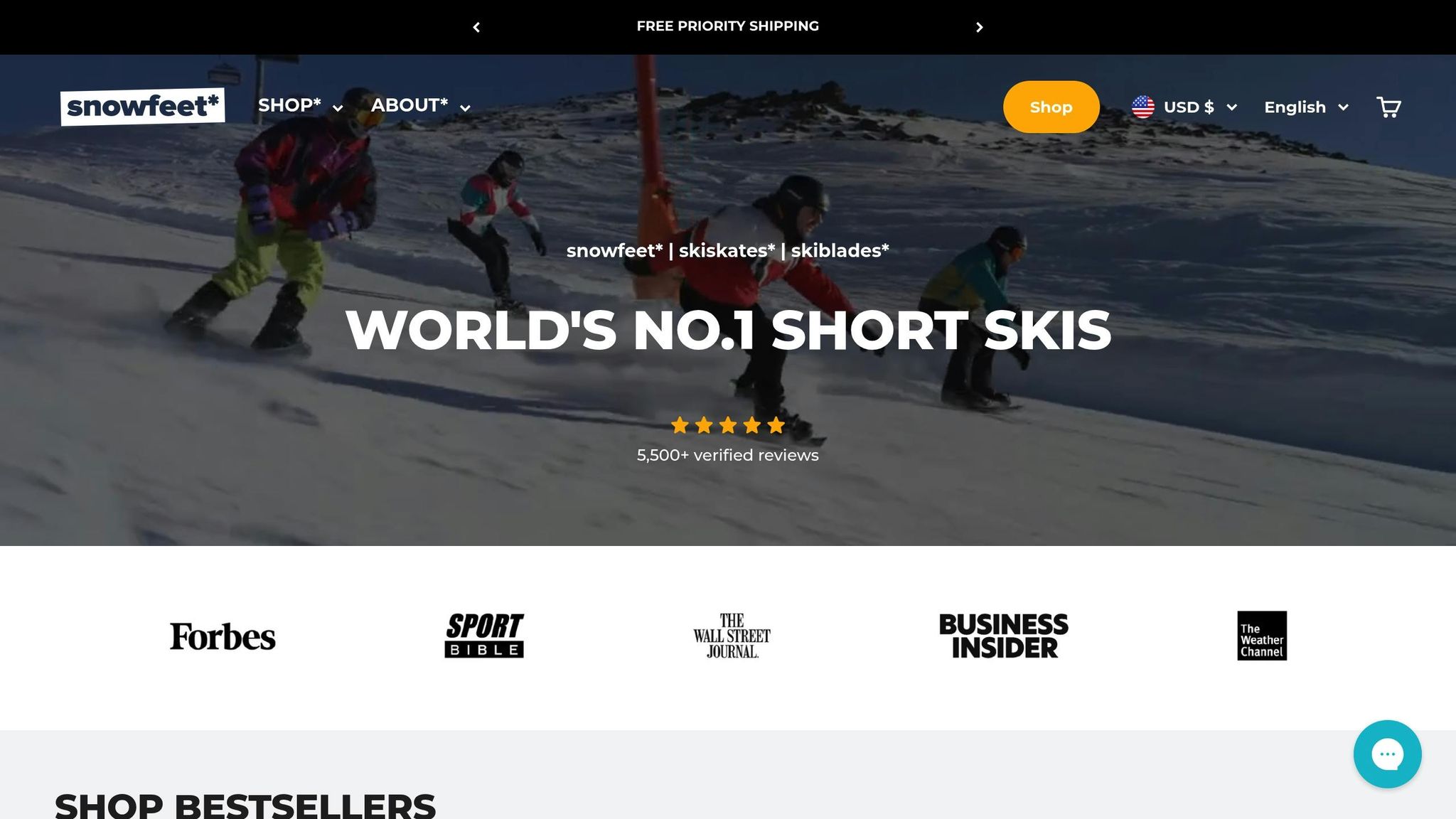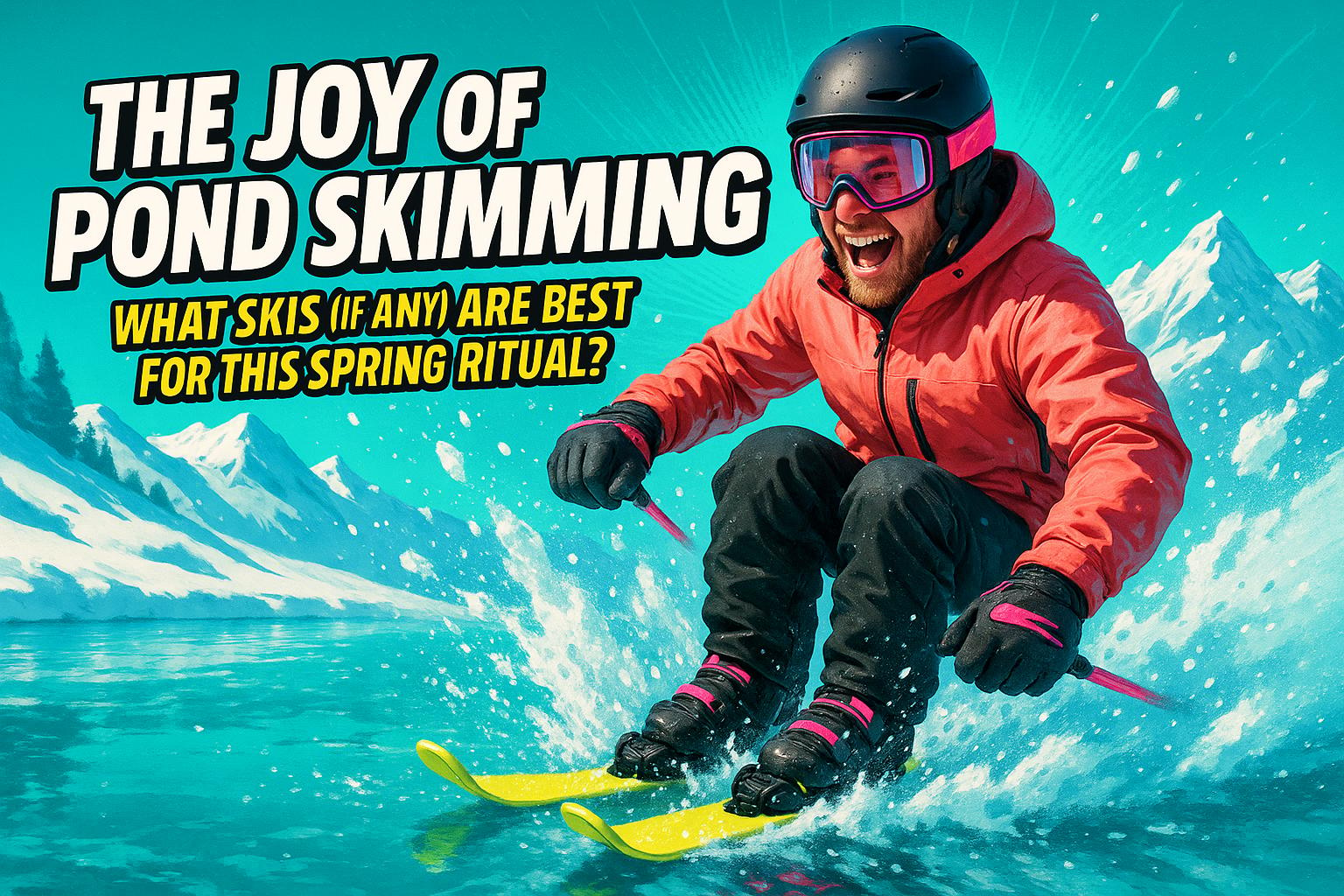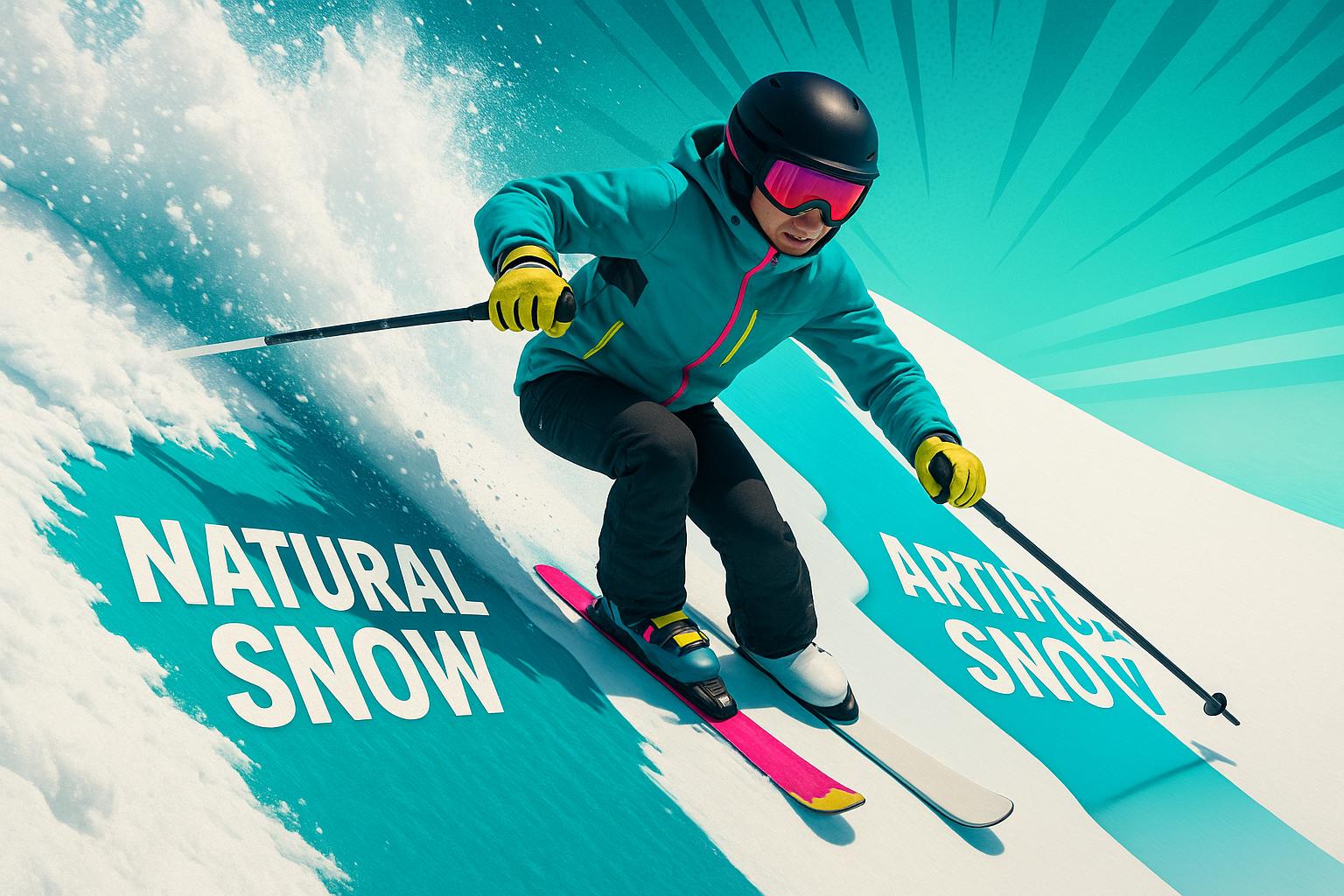When it comes to skis that feel "snappy" and "energetic", it’s all about design. Skis with quick rebound, lively responsiveness, and that playful "pop" make every turn more fun and less tiring. Shorter, lighter skis - like Snowfeet* skiskates and skiblades - are leading the charge, offering unmatched agility and energy compared to longer, heavier models from brands like Rossignol or Salomon.
Here’s the deal:
- Shorter Length: Easier to maneuver, faster edge-to-edge transitions.
- Lightweight: Reduces fatigue, perfect for tricks and quick movements.
- Balanced Flex: Not too stiff or soft, ensuring responsive control.
- Camber Design: Acts like a spring, giving that satisfying rebound between turns.
- Energy Return: Short skis flex and snap back faster, delivering instant feedback.
Snowfeet* products, ranging from 17.3 to 47.2 inches, focus on agility and playfulness, ideal for parks, moguls, and tight tree runs. Meanwhile, longer skis excel in stability at high speeds or deep powder but lack the same lively feel.
Quick Comparison:
| Feature | Snowfeet* Short Skis | Long Skis (Rossignol, etc.) |
|---|---|---|
| Agility | High | Moderate |
| Stability at Speed | Low | High |
| Weight | Light | Heavy |
| Best Terrain | Tight spaces, parks | Open slopes, powder |
If you want playful, energetic runs, shorter skis like Snowfeet* are a great choice. For speed and stability in open terrain, longer skis are the way to go.
2025 Men's 100 mm Ski Comparison - Part 1: Freeride Skis - with SkiEssentials.com

Key Features That Create Snappy and Energetic Ski Performance
Snappy, energetic skis are all about five key design elements that bring a quick, playful "pop" to your ride. Snowfeet* short skis nail this by design. These features determine how fast your skis react, how well they store and release energy, and how lively they feel underfoot.
Length is a big deal when it comes to ski responsiveness. Shorter skis need less effort to start a turn or switch directions, making them naturally more agile. For comparison, traditional skis from brands like Rossignol and Salomon are typically 63–71 inches (160–180 cm) long and can feel a bit sluggish to maneuver. Snowfeet* short skis, on the other hand, are built for instant reaction, avoiding that heavy, delayed feel you might get with longer alpine gear. And then there’s the matter of weight.
Weight plays a major role in how quickly you can move your skis during transitions. Heavier skis build up momentum, which can slow you down when changing direction. Lighter skis, like Snowfeet* skiblades and skiskates, make those quick, effortless movements possible. This lightweight design eliminates the drag often associated with traditional alpine skis, letting you make split-second adjustments with ease.
Next up is flex, which defines how your skis bend and snap back during turns. Too stiff, and your skis lose that lively feel. Too soft, and you’ll sacrifice power. Snowfeet* products hit the sweet spot, with flex patterns tailored to their shorter lengths. This balance of support and responsiveness gives you precise control without feeling rigid or sluggish.
Camber is another critical factor - it’s like the energy system of your skis. This slight upward curve in the ski’s profile acts like a spring, storing and releasing energy as you turn. As one expert puts it:
"A cambered ski will flex during a turn, absorbing and releasing energy for a sharp rebound".
That rebound is what gives you that satisfying snap between turns. Another expert adds:
"The camber design essentially dictates how much energy we can drive into our turns".
Finally, energy return efficiency ties everything together. Shorter skis complete their flex-and-rebound cycle faster than longer ones. With less material to bend and spring back, these skis release energy more quickly, delivering that signature snappy feel. Snowfeet* products combine these performance features into a compact design, giving you instant responsiveness while maintaining the stability you need to ski confidently on various terrains.
1. Snowfeet* Short Skis and Skiskates

Snowfeet* brings a fresh twist to skiing with their compact, energetic designs. Their lineup includes Skiskates, measuring just 17.3 inches (44 cm), and Skiblades, ranging from 25.6 inches (65 cm) to 47.2 inches (120 cm). For comparison, traditional alpine skis usually fall between 63–71 inches (160–180 cm).
Length and Maneuverability
With shorter lengths, Snowfeet* products offer unmatched maneuverability. While brands like Rossignol and Salomon design longer skis for stability, Snowfeet* focuses on quick responsiveness and agility. Their compact size makes edge-to-edge transitions a breeze and allows for effortless pivoting.
This design excels in tight spots where traditional skis can feel clunky. Whether you're navigating terrain parks, moguls, or narrow trails lined with trees, Snowfeet* skis provide the snappy, responsive feel you want from the moment you push off.
Weight and Portability
Weight is a game-changer when it comes to skiing. At just 2.6 lbs (1.2 kg) per pair, Snowfeet* skiskates are incredibly lightweight and easy to carry. This low weight reduces fatigue and makes quick, energetic movements - like tricks and jumps - more manageable.
Unlike traditional ski gear that often needs roof racks or racks up oversized baggage fees, Snowfeet* products are compact enough to fit in a backpack. Their lightweight design doesn’t just add convenience - it also enhances performance by supporting their unique flex and camber profiles.
Flex and Camber
The compact size and lightweight build of Snowfeet* skis are complemented by carefully designed flex and camber profiles. A moderate to soft flex in their Skiblades and Skiskates ensures a lively, responsive ride. Meanwhile, a traditional or slightly cambered underfoot design improves edge grip and provides a satisfying rebound.
This camber design works like a spring, storing and releasing energy as you ski. The result? A snappy "pop" when exiting turns or pulling off tricks. Unlike the rigid feel of some traditional skis, Snowfeet* products deliver immediate feedback, making every movement feel dynamic and connected.
Energy Return and Responsiveness
Snowfeet* skis shine when it comes to energy return. Thanks to their short length, lightweight construction, and fine-tuned flex, these skis rebound quickly after flexing. This creates a spring-like effect that propels you into your next movement, offering a playful, energetic skiing experience.
Key design elements - like the short, light build, balanced flex, and slightly cambered shape - work together to maximize this rebound effect. The result is a setup that responds instantly to your input, prioritizing agility and fun over raw speed or deep powder performance. For skiers who love dynamic, playful runs, Snowfeet* delivers what longer, traditional skis simply can’t match.
sbb-itb-17ade95
2. Traditional Long Skis
When you think of classic alpine skis, brands like Rossignol, Salomon, K2, and Völkl come to mind. These skis usually range from 63 to 71 inches (160–180 cm) in length. Unlike Snowfeet* designs, which focus on agility and quick movements, traditional long skis prioritize stability and control at high speeds. The trade-off? They tend to lack the playful, lively feel that many skiers enjoy.
Length and Maneuverability
Long skis shine when it comes to stability, especially at higher speeds. But they’re not as quick to respond in tight or creative terrain. Their extra length makes sharp turns and quick pivots more challenging compared to the compact and nimble Snowfeet* gear.
Professional skier Tom Wallisch shares his perspective:
"For length of skis I'm a big fan of having a ski long enough to stomp landings and ride stable in all terrain. But I do think bigger isn't always better. I ski very freestyle oriented and love quick more maneuverable skis in trees and on chunder. I love something 185 or shorter even though I could ski something bigger."
Shorter skis are the go-to choice for navigating tighter spots like trees and moguls. Professional skier Veronica Paulsen breaks it down:
"When I am skiing in the backcountry and have wide open faces or big airs, I definitely prefer a longer ski. If I know I'll be in the trees and want some more maneuverability, I might go shorter for the day, maybe more around 175."
Weight and Portability
Weight is another factor that sets traditional skis apart. Heavier skis provide stability in rough conditions and at high speeds but can feel cumbersome when you need quick pivots or are tackling moguls. Plus, they’re bulky to store and transport, unlike the lightweight, portable Snowfeet* options.
Flex and Camber
Traditional long skis often feature stiffer flex patterns and specialized camber designs. These elements are great for maintaining power and edge grip but can make the skis feel less lively. In conditions where adaptability is key, this rigidity can be a drawback compared to the poppy, energetic response of Snowfeet* gear.
Energy Return and Responsiveness
The combination of length, weight, and stiffness in traditional skis means they release energy more slowly. This makes them stable at high speeds but less responsive and playful at slower speeds. In contrast, shorter, lighter skis like those from Snowfeet* offer a quicker, snappier rebound.
Professional skier Ross Tester sums it up perfectly:
"I would say there's a time and place for both shorter and longer skis. The lines can be blended to an extent, but at the end of the day, bigger is better for fast, big lines, and short is great for slower speed, more creative/tricky riding."
In short, traditional long skis are built for high-speed, wide-open scenarios. But if you’re craving that energetic, playful vibe, they might not deliver the same level of fun and responsiveness.
Pros and Cons
Deciding between Snowfeet* short skis and traditional long skis comes down to understanding how each option performs in different scenarios. Here's a breakdown of their strengths and trade-offs to help you make the best choice for your skiing style.
| Feature | Snowfeet* Short Skis & Skiskates | Traditional Long Skis |
|---|---|---|
| Agility & Quick Turns | Excellent - sharp and precise in tight spaces | Moderate - needs more effort and room |
| Stability at Speed | Limited - ideal for moderate speeds | Excellent - steady at high speeds |
| Playfulness & Energy | High - lively and fun | Moderate - depends on the model |
| Float in Powder | Poor to moderate - smaller surface area | Excellent - great for deep snow |
| Weight | Ultra-light - easy to carry and maneuver | Heavier - can be cumbersome |
| Learning Curve | Short - beginner-friendly | Longer - more skill required |
| Portability | Fits in a backpack - travel-friendly | Bulky - needs roof racks or ski bags |
| Price Range | $150-$690 (Snowfeet* models) | $400-$800+ (premium brands) |
| Best Terrain | Parks, moguls, trees, urban areas | Open slopes, backcountry, mixed conditions |
Let’s dive deeper into what these differences mean for you.
Snowfeet* Short Skis and Skiskates
Snowfeet* gear is all about compact design and lightweight agility. Their quick response makes them a dream for tight spaces like tree runs or terrain parks. With their precise pivoting, you can effortlessly weave through obstacles or pull off tricks. Plus, their portability is a game-changer - Skiskates, for instance, are just 44 cm long and light enough to toss in a backpack, saving your legs from fatigue after a full day of fun.
That said, they do have their limits. Their shorter length struggles in deep powder, and they’re not the best choice for riding over choppy, uneven snow.
Traditional Long Skis
Long skis from brands like Rossignol and Salomon shine in stability and versatility. They’re built for speed and handle a wide range of mountain conditions with ease. Whether you’re cruising down open slopes or exploring the backcountry, these skis deliver a solid, reliable ride.
However, their size and weight can feel like a drawback. Quick turns demand more effort, and transporting them - especially if you’re traveling - can be a hassle compared to the compact convenience of Snowfeet* gear.
Ultimately, your choice should reflect your skiing preferences. Are you all about agility and playful runs in tighter spaces? Or do you crave speed and stability on expansive slopes? The gear you pick will shape your experience on the mountain!
Conclusion
Shorter, lighter skis offer a skiing experience that's fast, fun, and full of energy - something you just don’t get with traditional long skis. Their reduced length, lightweight build, and responsive flex make every turn feel lively and effortless.
Snowfeet* products have become a favorite for skiers across the U.S. who crave agility and playfulness on the slopes. Their compact size makes for quick transitions, smooth pivots, and an energetic ride that stands out compared to traditional skis. This isn’t just marketing talk - the difference is clear both on the mountain and in the glowing feedback from users.
With over 5,500 verified reviews, Snowfeet* has built a strong reputation. As founder Zbyněk explains:
"In my opinion, Skiskates is the best product for slopes we developed so far. I love how easy they are to ski and skate and how many different kinds of tricks I can perform without much effort and almost no restrictions." – Zbyněk, Snowfeet* Founder
For skiers who love terrain parks, moguls, or weaving through tight tree runs - whether you’re in Colorado or Vermont - Snowfeet* products shine. Their compact design makes them perfect for these challenging environments, where quick and precise movements are key. Plus, with prices ranging from $250 to $690, they deliver great performance without breaking the bank. And let’s not forget the convenience: their small size means no need for roof racks or oversized bags, making transportation a breeze.
FAQs
Why are Snowfeet* short skis perfect for tight, playful terrains compared to traditional long skis?
Snowfeet* short skis, measuring just 26 inches (65 cm), are all about agility and quick reactions. Their compact size makes them perfect for weaving through tight spots, handling crowded slopes, or tackling narrow trails. Plus, they’re a blast for pulling off tricks and jumps, thanks to their easy maneuverability.
Compared to traditional longer skis, which are built for speed and stability on wide, open runs, Snowfeet* short skis bring a whole different vibe. They’re lightweight, which means better control and less fatigue, letting you explore compact or tricky terrains with a playful, adventurous edge.
What makes the camber design in Snowfeet* products deliver such a snappy and energetic feel?
The camber design in Snowfeet* gear is what gives it that lively, responsive edge. It enhances edge contact and provides a quick rebound, making your turns sharp and controlled. This level of precision and pop is something traditional long skis often can't keep up with. The result? Effortless carving and a ride that's as playful as it is dynamic.
What sets Snowfeet* apart even more is their lightweight, compact build. Unlike the bulkiness of traditional skis, these shorter and lighter options - whether you're using Skiblades, Skiskates, or Mini Skis - team up with the camber to create a ride that's perfect for high-energy, fun-packed winter days.
Are Snowfeet short skis good for beginners, and what makes them easier to learn on compared to traditional skis or snowboards?
If you're new to skiing, Snowfeet short skis are a game-changer. Their compact and lightweight design makes them much easier to handle than traditional skis or snowboards. Because they're shorter, they allow for quick, sharp turns, which is perfect for building confidence and improving your skills right from the start.
Unlike standard long skis, Snowfeet are more forgiving and easier to control. This means you won't have to wrestle with heavy, awkward gear - instead, you can focus on having fun and getting the hang of things. For anyone looking to dip their toes into winter sports without feeling overwhelmed, Snowfeet short skis are a solid pick.

































Leave a comment
This site is protected by hCaptcha and the hCaptcha Privacy Policy and Terms of Service apply.